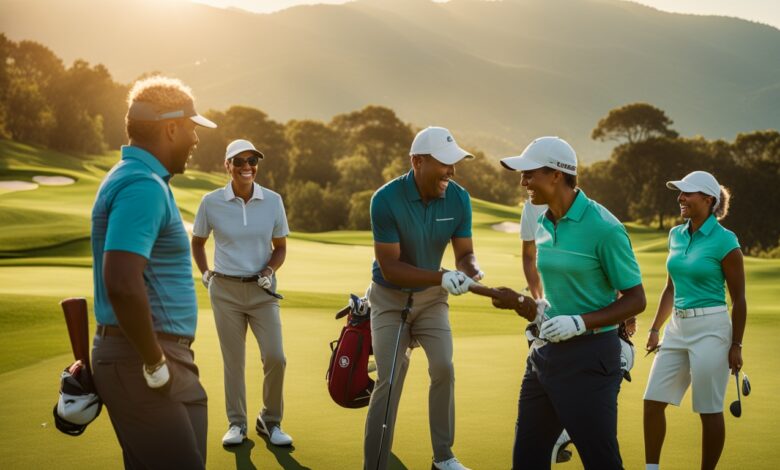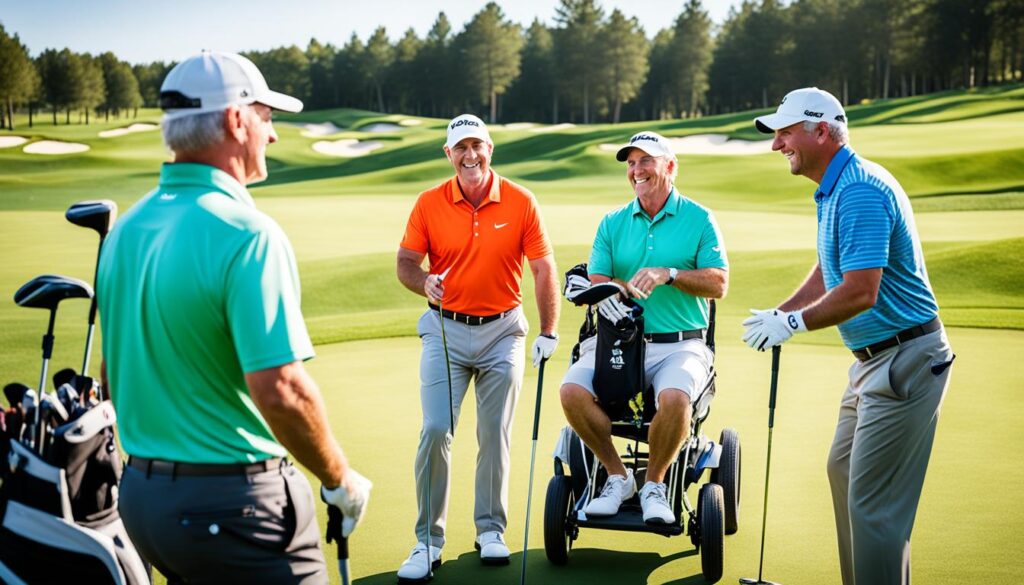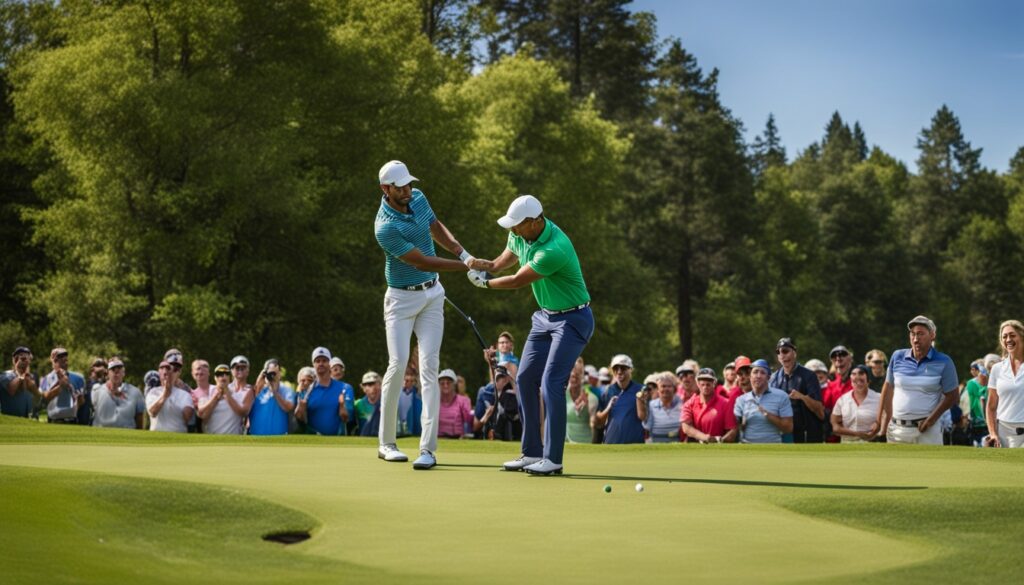Breaking Barriers: Addressing Golf Discrimination

Golf is a sport often dominated by men. However, women have been achieving more recognition. Female golfers such as Mary Queen of Scots, Helen Kicks1, and Babe Zaharias1 have shown their skill. They battled gender discrimination at the sport’s start, their success helping change how we see women in golf.
By the late 19th century, women’s golf was on the rise. It led to the creation of women’s clubs and associations2. British golfer Issette Pearson notably won a national championship in 1893. This victory inspired other women to join the game2. Tournaments like the Women’s British Open and the U.S. Women’s Amateur Championship started highlighting women’s golf skills2.
Key Takeaways
- Golf has long been dominated by men, but women are making strides in the sport.
- Pioneering female golfers like Mary Queen of Scots, Helen Kicks, and Babe Zaharias have faced significant gender discrimination but have helped break down barriers.
- Women’s golf clubs, associations, and tournaments have provided platforms for female golfers to showcase their skills and inspire others to take up the sport.
- The Ladies Professional Golf Association (LPGA) has been instrumental in advancing the careers of female golfers and creating a platform for them to compete at the highest level.
- Inclusive initiatives and programs are needed to continue addressing golf discrimination and promoting diversity and accessibility in the sport.
Pioneering Women in Golf’s Storied History
Women have played a key role in golf’s history, breaking gender barriers and inspiring others. They include the “Mother of Golf” and champions who paved the way for future female golfers. Their stories highlight determination and resilience against all odds.
Mary Queen of Scots: The Mother of Golf
Mary Queen of Scots is known as the “Mother of Golf.” She played as a Scottish royal, which was rare for women in her time3. Her love for the game broke societal norms and encouraged more women to play, lifting women’s golf status. She inspired future female golfers with her bravery.
Helen Kicks: Founding Member of the LPGA
Helen Kicks was instrumental in the creation of the Ladies Professional Golf Association (LPGA), the top organization for women golfers3. Her commitment and initiative opened doors for female golfers. Thanks to her work, many women could pursue careers in professional golf.
Babe Zaharias: Trailblazer and Champion
Babe Zaharias was a standout American golfer who turned pro in 1947. She won 82 golf tournaments3. Zaharias was a founding member of the LPGA. She was the first woman to play in the Los Angeles Open, making history and inspiring future female athletes. Her incredible accomplishments and spirit stand as a tribute to women’s power in golf.
The stories of these women remind us of the struggles for gender equality in golf34. Their victories and contributions have made the sport more inclusive. They motivate others to aspire and break through barriers in the sport.
Overcoming Gender Discrimination on the Course
For many years, women in golf have been held back by gender discrimination. They found it hard to get the same chances as men, whether in tournaments or earning respect5. Even now, issues like subtle gender bias and slow progress on diversity goals affect women5. Some believe that only behaviors considered “male” lead to leadership roles, which sidelines women5.
Other men in power often support more men than women, due to the idea that those similar to us will do better5.
Struggles for Equal Opportunities
Golf has seen some change, especially thanks to women pioneers and shifting cultural attitudes. Still, women face obstacles, such as being left out of key decisions5. Companies and leadership roles in golf are trying to promote diversity but are stuck in old habits5.
Training programs that aim for more gender diversity in golf face challenges too5. This is because of persistent biases and stereotypes against women5.
Changing Perceptions and Cultural Norms
Over time, things are improving for women in golf. Society is starting to see the value of women’s roles in the sport. Women’s contributions and potential on the course are gaining recognition6. Following the 2019 FIFA World Cup, the U.S. women’s soccer team pushed for equal pay, which was achieved in May 2022 by many soccer associations6.
Although there’s progress, gender discrimination remains a big issue in sports like golf. Media coverage doesn’t give much attention to women’s sports, a problem that has barely improved over time6. In golf, where there are high costs to play, this can also impact minority athletes, making it hard for them to start6.
“Gender discrimination and the lack of opportunities for women in golf have been longstanding issues, but the efforts of these trailblazers and the gradual shift in cultural attitudes are slowly breaking down these barriers.”
Improving equality and fighting gender discrimination is crucial. The golfing industry must become a place where everyone can succeed. With these changes, women can do well in golf and beyond567.
Racial Barriers and Segregation in Golf
Golf, often seen as exclusive, has a history marked by racial discrimination. Black golfers couldn’t access public courses for years. In Minneapolis, these courses were segregated until the 1950s8. Even after integration, like at Hiawatha Golf Course in Minnesota, flooding has been a big issue8.
The roots of segregation in golf run deep. The United Golfers Association was born, also called the United States Colored Golf Association. This happened mainly after World War II. African American newspapers covered their events and fight against discrimination heavily9. But, history focuses more on big events and people, forgetting how everyday life was hard for many Black golfers back then9.
Racism impacts golf to this day, especially in urban public courses. These courses, often used by Black golfers, suffer more from climate changes than private ones in wealthy areas8. A $44 million plan for Hiawatha Golf Course might change nine holes into wetlands. This plan shows the need to balance history, systemic racism, and nature protection8.
Golf is working hard to break down its racial barriers and segregation. With more awareness and a focus on diversity and inclusion, golf can become fair and open to all8910.
“If it wasn’t for Charlie, I probably wouldn’t be here.”
– Tiger Woods, recognizing Charlie Sifford, the first African American on the PGA Tour10.
Breaking Barriers: Addressing Golf Discrimination
Inclusive Initiatives and Programs
In the past few years, the golf world has worked hard to stop discrimination and welcome everyone. The PGA and LPGA are leading the way by starting many programs. These efforts are helping more women and people of color to join the sport11.
The PGA of America, which started 102 years ago, is a key player in these efforts. They agreed in 1978 that women could also be PGA pros, signing the Naismith Consent Degree11. Then, in 2003, Suzy Whaley made history by qualifying for a PGA Tour event. She was the first woman in 58 years to achieve this11.
The LPGA is boosting diversity and inclusion too. They launched a special Michelle Wie West LPGA hoodie, which quickly sold out twice this year. All the money from the sales goes to help two important charities. These charities help give more chances to those who haven’t had many in golf12.
Promoting Diversity and Inclusion
Both the PGA and LPGA are trying to make golf more fair and friendly for all. They have made rules against discrimination and organized tournaments that are open to everyone. For example, in 2014, the PGA president was removed for making bad remarks about a player. This shows that the sport does not accept such behavior13.
The PGA of America welcomed its first female president, Suzy Whaley, in 2018. She won with 53% of the votes and is working hard to make the PGA more inclusive. Her efforts are making a big change1113.
These steps by golf groups are very important. They are making golf a sport where more people feel they belong. By giving more chances and better representation, golf is becoming a friendlier place for everyone. This will encourage more people, especially the young, to play and work in golf12.

“Golf is an $84 billion industry, and it is considered an incredible networking opportunity that can help in career advancement. However, the cost of equipment, lessons, and access to golf courses are real barriers to playing the game. Supporting charities addressing these needs is crucial for promoting golf among young girls.”12
Golf as a Catalyst for Social Change
Golf goes beyond just playing; it changes society. Women and minority golfers have broken barriers. Their achievements inspired diversity in the sport, showing golf’s power for fairness.
Role Models and Success Stories
The 20th century’s Civil Rights Movement made great impact, like in sports. Figures like Jackie Robinson and Jesse Owens opened doors. They proved talent knows no race.
Golf, once mostly white, saw change too. Athletes like Bill Russell showed the world black excellence. They inspired more diversity in all sports.
Yet, the golf world still has a way to go in being truly inclusive14. Few people play regularly, and there’s a lack of diversity in professional golf14. The First Tee is making golf more accessible to all, especially women and minorities14.
England Golf is working hard for change, too. Their ED&I Framework aims for a more equal golf world15. It encourages opportunity for all and celebrates diversity15.
The Respect In Golf initiative is part of this mission. It pushes for golf to be open to everyone, regardless of background15. By making clubs more welcoming, they fight against discrimination15.
“Golf should be a sport that is accessible to people of all ages, genders, backgrounds, and abilities to create a truly inclusive environment.”
The R&A wants everyone to feel welcome in golf15. Working with passion, they aim for a sport open to all1614.
Adaptive Golf: Inclusivity for Persons with Disabilities
Golf was once seen as only for a select few, mostly men. Recently, the sport has changed for the better. Adaptive golf programs, courses designed for everyone, and special equipment have made golf more open. Now, more people can play, regardless of their physical challenges17.
The effort to make golf courses welcoming to all is crucial17. Steps taken include following strict accessibility standards, even beyond the golf course. This ensures that every golfer, no matter their needs, can fully enjoy the game17.
Golf is proven to benefit the health and happiness of many18. It’s a sport that welcomes all, no matter their age or skill. But, people with disabilities might face more health hurdles, like heart conditions or feelings of being left out18. Sadly, not many disabled people find their way into the game. Overcoming challenges to keep playing regularly is tough for some18.
Yet, the golf world is making strides. In the U.S., more people played golf in 2019, and even more in 2020 despite the pandemic19. The U.S. Adaptive Open set for July 2022 at Pinehurst is a big step forward19. There, 96 golfers with physical challenges will compete. This event aims to encourage more adaptive golfers and show their talent to the world19.
These steps and events are shaping a more open and inviting landscape in golf. The future looks bright for adaptive golf, with its potential for more accessible and rewarding experiences. This progress promises everyone, including those with disabilities, the chance to fully enjoy the beauty of golf17.

“Golf’s attributes make it suitable for individuals with diverse abilities, and there are few age or skill limits to participation.”18
Youth and Community Outreach Programs
Golf organizations and communities see the need to reach young people and underserved groups. They want to make golf more diverse and inclusive. They use youth golf programs, education, and community outreach efforts. The goal is to show a wider group of people the joy of golf. By breaking down cultural barriers and making the game more accessible, they aim to create a varied group of golf lovers.
Fostering Diversity from an Early Age
One successful example is the RISE program. Its focus is on respect, inclusion, and fairness in sports. 96% of those involved said they learned something they could use right away. Plus, 97% wanted to learn more about different races and diversity topics20. 93% felt ready for tough talks about such topics, and 97% were prepared to step in if they saw someone being discriminated against20.
The Breaking Boundaries program was another great initiative. It ran from 2018 to 2022. This project worked with over 100 young people aged 14-25 every year and their community groups, making them ‘Community Champions.’21. Across five UK cities, it intended to change how people in communities saw cricket. It wanted to make cricket more open, trustworthy, and welcoming21. The focus was on social harmony and personal health. The outcome was that volunteers gained skills to improve their lives and job prospects21.
These schemes show the positive impact of youth and community outreach programs. They make golf more welcoming and diverse. By reaching out to more people and breaking down cultural barriers, these programs can make golf a more inclusive place for all.
“Sports have the power to change the world. They have the power to inspire, the power to unite people in a way that little else does.” – Nelson Mandela
Economic Accessibility and Affordable Golf
Golf has faced challenges in becoming more inclusive because it seems too expensive for many22. Yet, efforts are underway to change this. Organizations and communities worldwide are making public and municipal golf courses more accessible. They’re also providing funds and programs to ease the cost of playing golf for people of all income levels22. By doing this, they hope to welcome more people who couldn’t afford to play before.
Public Courses and Municipal Golf
Public and municipal golf courses stand out as key places for people of any wealth level to enjoy the game22. This is important because the high costs of private clubs often keep many people away. Public courses, however, are much more affordable. For instance, a study in Chicago revealed that private clubs are not always as open to women as they are to men. They also have steep fees, sometimes charging as much as $30,000 to join23. But with public courses, golf is within reach for everyone, not just the wealthiest.
Equipment Grants and Charitable Programs
On top of public courses, there are initiatives to help cover the cost of gear22. These efforts provide free or low-cost equipment to players who can’t afford it. This makes starting the game easier for people from low-income families22. Also, some charities collect used equipment to give to those in need. By helping with equipment costs, these programs further open up the game to everyone22.
| Characteristic | Private Clubs | Public/Municipal Courses |
|---|---|---|
| Accessibility | Limited and exclusive | Open to the public |
| Initiation Fees | $30,000 on average | Minimal if any |
| Monthly Dues | Up to $400 | Cost-friendly for most |
| Diversity and Inclusion | Been known to exclude women and minorities | Warmly welcomes all |
Golf is becoming more open thanks to the emphasis on public courses and financial aid programs22. These steps are vital in ensuring that golf is for everyone, regardless of income. By making the sport more affordable and approachable, a diverse range of individuals can enjoy it.
“Offering money equivalent to the golf package spent on men for a day trip and activities outside of golf is being considered for the female employees.”24
Some companies are addressing the golfing gap for women by offering different activities24. With options that go beyond golf, they hope to bridge the inclusion gap. These actions are working towards a golf community that values a variety of interests and opens its doors to all.
Championing Diversity in Golf Organizations
Golf groups now see the big value in having diverse leaders and ways of running things. They’re picking different people for top jobs and making chances for those who would not usually get them. They also work together on projects that really change things for the better25.
Using tech and online spaces, more golfers are sharing their stories. Groups and new rules help make the game fairer and open to all26.
- They’re getting more kinds of people to important places in golf groups.
- There are programs where those not usually seen in golf can meet and learn from others.
- People from golf, people who push for rights, and those who make the rules are all working together. They’re breaking down big problems and making sure everyone feels welcome.
But, golf still has more work to do to be truly open and fair26. They’re pushing to end bad treatment because of race or gender and make golf cheap enough for anyone who wants to play27.
| Demographic | Share of Golfers | Share of Population |
|---|---|---|
| White British | 98.1% | 82.3% |
| Black British | 1.7% | 3.1% |
| Black Recreational Members | 0.5% | N/A |
Making golf more welcoming and fair is key for its future. It draws in a wide range of people, guaranteeing the game’s health and growth26.
“The battle over Augusta National’s exclusion of female members involved key figures such as William ‘Hootie’ Johnson (chairman of Augusta National) and Martha Burk (chairwoman of the National Council of Women’s Organizations), amongst others in a supporting role.”27
When golf is fair and open, everyone wins. The sport gets better, bringing people together and making society better too252627.
Conclusion
The golf world is making big steps to end discrimination and be more welcoming. It’s focusing on making an environment that accepts everyone. This means reaching out to all people, celebrating differences, and making the game open to all. By doing this, golf can become a sport where everyone feels they belong. Working together is key to bring real diversity to golf28.
Let’s not forget the big moment when women were allowed at prestigious clubs like the Royal & Ancient and Augusta National. This was a major win for inclusivity in golf28. Still, not all clubs are as welcoming to women, a UK study showed28. There’s also a big gap in prize money between women and men players. This shows there’s a lot of work to do to make things fair for everyone28.
When it comes to race, golf has its share of issues, like the past support of policies that hurt African American fans29. But, there’s been change thanks to people like Jackie Robinson and Serena Williams. They’ve shown that being different doesn’t mean you can’t succeed in the game30. Programs such as the Rooney Rule and groups like the Jackie Robinson Foundation and RISE are helping to make golf more equal. Though there is more to do, these steps show the sport is on its way to being a place for everyone30.
FAQ
What is the history of women’s involvement in golf?
What were some of the challenges faced by pioneering women golfers?
Has golf also faced issues of racial discrimination and segregation?
How has the golf industry responded to address discrimination and promote greater inclusivity?
How has golf served as a catalyst for broader social change?
What initiatives have been taken to enhance inclusivity and accessibility for individuals with disabilities in golf?
How are golf organizations and communities addressing the perceived economic inaccessibility of the sport?
How are golf organizations championing diversity within their leadership and operations?
Source Links
- https://www.thegolfbusiness.co.uk/2023/04/women-in-golf-breaking-barriers-and-making-history/ – Women in golf: Breaking barriers and making history
- https://www.tennesseenational.com/blog/women-in-golf-promoting-inclusivity-in-the-sport – “Women in Golf: Promoting Inclusivity in the Sport” | Tennessee National Blog
- https://hostziza.com/the-15-most-successful-and-famous-black-golfers-in-history-celebrating-legends/ – The 15 Most Successful and Famous Black Golfers in History: Celebrating Legends – Hostziza
- https://www.generationalgolf.com/articles – Articles — generational golf
- https://hbr.org/2013/09/women-rising-the-unseen-barriers – Women Rising: The Unseen Barriers
- https://www.caseiq.com/resources/discrimination-in-sports-5-types-25-solutions/ – Discrimination in Sports: 5 Types, 25 Solutions | Case IQ
- https://goalfive.com/blogs/news/how-to-fix-gender-inequality-in-sports – Fixing Gender Inequality in Sports
- https://www.eenews.net/articles/climate-project-reveals-racial-tensions-at-minn-golf-course/ – Climate project reveals racial tensions at Minn. golf course
- http://shelf1.library.cmu.edu/HSS/2011/a1436091.pdf – Microsoft Word – SBSTGolf.docx
- https://www.golfdigest.com/story/pga-championship-2022-bill-spiller-broke-golfs-color-barrier-southern-hills – Bill Spiller: The man who broke golf’s color barrier
- https://www.news-journal.com/etvarsity/pro/a-golf-pro-first-suzy-whaley-now-breaking-barriers/article_9cb1fa8c-e212-11e8-ba1d-a7ae1b042b3e.html – A golf pro first, Suzy Whaley now breaking barriers
- https://www.atrinternational.com/2021/05/19/why-we-should-help-girls-play-golf/ – Why We Should Help Girls Play Golf
- https://apnews.com/article/6f46390c1f534aabaf54776b22391fd9 – Column: A golf pro first, Suzy Whaley now breaking barriers
- https://www.linkedin.com/pulse/why-women-companies-should-invest-golf-professional-anya-alvarez – Why Women and Companies Should Invest in Golf for Professional Development
- https://assets.randa.org/c42c7bf4-dca7-00ea-4f2e-373223f80f76/400c2f63-299a-45b3-90fc-139967404e98/The R&A Developing Golf – Issue 7.pdf – PDF
- https://www.coursesidekick.com/arts-humanities/2732439 – The Integration of Sports in America: Catalyst for Change and
- https://centreforinclusivedesign.org.au/blog/2023/08/15/ep-19-golf-anyone-golf-course-designer-christine-fraser-breaks-barriers-to-make-golf-an-inclusive-sport/ – EP 19: Golf anyone? Golf course designer, Christine Fraser, breaks barriers to make golf an inclusive sport. – Centre for Inclusive Design
- https://www.golfsciencejournal.org/article/27614-benefits-barriers-and-facilitators-to-golf-participation-among-disabled-people-identifying-opportunities-to-increase-uptake-and-foster-inclusion – Benefits, Barriers and Facilitators to Golf Participation Among Disabled People: Identifying Opportunities to Increase Uptake and Foster Inclusion | Published in International Journal of Golf Science
- https://www.degruyter.com/document/doi/10.1515/jom-2022-0131/html – Paralympic golf movement: the links between inclusion and treating the whole person to regain function
- https://www.risetowin.org/who-we-are/index.html – RISE
- https://www.sportingequals.org.uk/projects/breaking-boundaries/ – Breaking Boundaries – Sporting Equals
- https://openscholarship.wustl.edu/cgi/viewcontent.cgi?article=1135&context=law_globalstudies – No Women (and Dogs) Allowed: A Comparative Analysis of Discriminating Private Golf Clubs in the United States, Ireland, and England
- https://www.chicagotribune.com/1991/05/05/private-golf-clubs-resist-rising-winds-of-social-change/ – PRIVATE GOLF CLUBS RESIST RISING WINDS OF SOCIAL CHANGE
- https://www.askamanager.org/2019/05/our-traditionally-male-company-has-an-annual-golf-trip-but-our-new-female-employees-dont-play.html – our traditionally male company has an annual golf trip — but our new female employees don’t play
- https://www.washingtonpost.com/opinions/2021/04/08/masters-tradition-is-rooted-racism-sexism/ – Opinion The Masters’ ‘tradition’ is rooted in racism and sexism
- https://blog.thesocialgolfer.com/golf-and-diversity-the-black-hole/ – Golf and Diversity | The BLACK Hole | The Social Golfer
- https://via.library.depaul.edu/cgi/viewcontent.cgi?article=1092&context=jslcp – Prerogative or Prejudice?: The Exclusion of Women from Augusta National
- https://www.theinsuranceemporium.co.uk/blog/women-in-golf-the-truth/ – A Level Playing Field: Female Golfers Saying No to Inequality
- https://digitalcommons.law.villanova.edu/cgi/viewcontent.cgi?article=1126&context=mslj – An Unimproved Lie: Gender Discrimination Continues at Augusta National Golf Club
- https://papersowl.com/examples/racism-in-sports-essay/ – Racism in Sports Essay – Free Essay Example | PapersOwl.com

